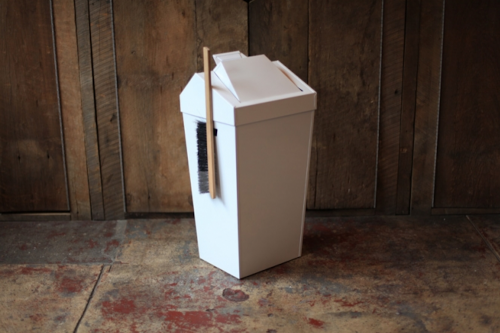 click > enlarge
click > enlarge
Brendan Ravenhill was one of a dozen designers whose work was on display at Noho Design District’s “Hotel California” exhibition at The Standard during NY Design Week. Like all the designers, Ravenhill lives and works in California, specifically Los Angeles, where his products are both designed and manufactured. He had a couple of powder-coated beauties on display, like his Signal Shelves (below), made from maple plywood set off by red steel brackets. My favorite, however, is his clever Dustbin, which Ravenhill describes as “the lovechild of a trash can and a dustpan.”
A natural bristle brush attaches to the side of the bin via “rare earth magnets,” and the swinging lid doubles as a dustpan. “The simple elegance of the Dustbin lies in the counter-balanced dustpan, which uses a heavy gauge steel handle to balance out the aluminum pan.” Ravenhill let me test it out by offering me his wallet to drop inside, where it landed with a satisfying clink of the lid. At $250 it may not be the most affordable trash can on the market, but it’s so well made and thoughtfully designed that Ravenhills calls it “the last trash can you’ll ever buy.” Watch a video of the Dustbin being made and tested.
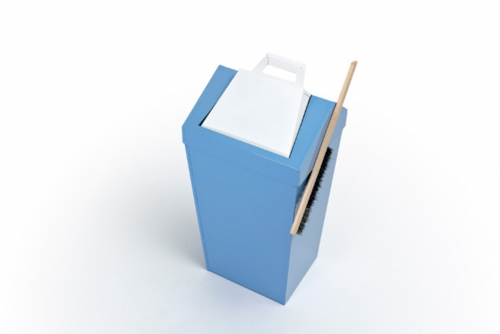

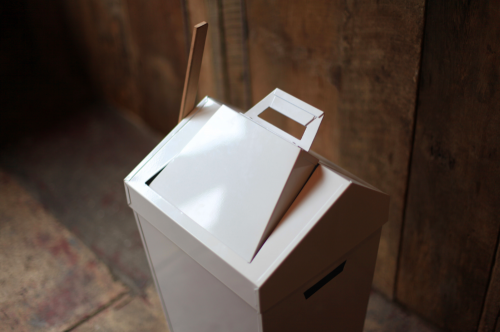

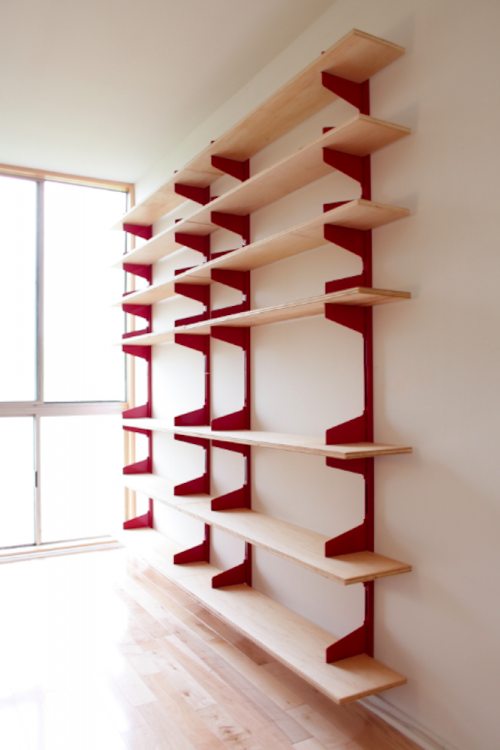
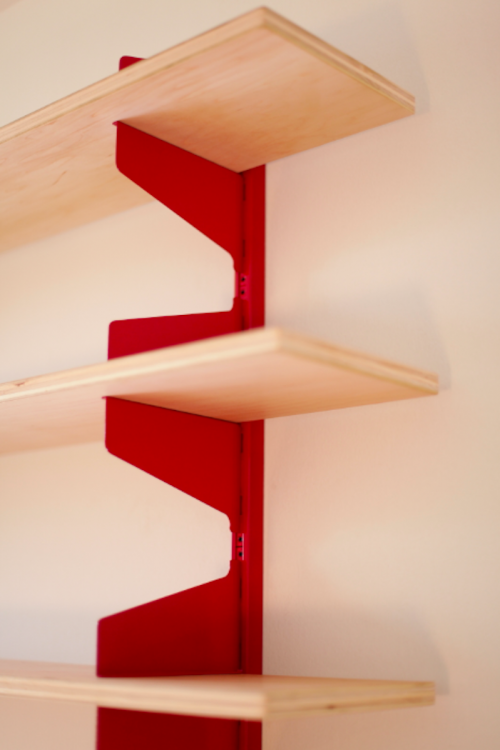

about perrin drumm
 click > enlarge
click > enlarge
Graypants is a design studio and think tank based out of Seattle and Amsterdam that takes on a wide range of projects, from larger architectural commissions to furniture and lighting. Where their smaller products are concerned, it’s clear that Graypants makes their materials work as hard as possible. The sleek Slice chair (below) gets the most out of a single sheet of plywood. Three entire chairs can be made from just one sheet, and because the low-VOC finish is a byproduct of cheese (yes, really), the only waste is the saw dust.
At ICFF this year, Graypants showed off their stunning cardboard-based lighting collection. Available in a variety of shapes from perfect circles to oval pendants, each light is made of thin strips of laser-cut cardboard that are glued one on top of the other. Because of the irregularities in the cardboard’s honeycomb structure, the light shines through in unique ways particular to each individual light. In certain lights, like the Drum or the Bell (below), the cardboard rings are arranged to create a subtle pattern. The lights, which range in price from $179 – $1,399, can be purchased directly from graypants’ online shop.







about perrin drumm
 click > enlarge
click > enlarge
If what we store on our flash drives is important enough to back up lest we lose it forever, why do we toss the physical drives around without a second thought? I used to keep my flash drive on my key chain where it rattled around against relatively sharp metal objects and got crammed into the black hole of my purse, trusting a little plastic cap to keep all my most important files safe. At the designboom mart at ICFF I saw a design team who’s getting people to rethink how they treat their flash drives with a collection made from materials as precious as your files.
Logical Art is a small operation run by Yoo-Kyung Shin and Hanhsi Chen, who spread their time between Korea, Taiwan and the UK. Together they’ve created Empty Memory, a line of flash drives made out of wood, plexi and stainless steel as well as more luxurious offerings in silver, gold and rose gold. The plexi/wood model is the most streamlined of the bunch, whereas the metal drives have a more complex geometrical finish. You can buy them directly from the designers for $75-$95.



about perrin drumm
 click > enlarge
click > enlarge
Craft System, the new lighting collection by François Chambard of UM Project, might just be the most imaginative interpretation of a lamp I’ve ever seen. When all the lamps are lined up side by side they look more like characters from a children’s story – think Wall-E’s progeny – than even the most inventive lighting on view at WantedDesign during NY Design Week. François describes the collection as one basic form with multiple variations. The most basic variation in the system, the Atum Lamp, has a Corian base in black, grey or white with a shade of either a fabric mesh or powder coated satin brass. There are two options for the light source, either an LED grid or four small incandescent light bulbs (both are operated with a built-in dimmer switch), and you can choose the table top variety or make it into a floor lamp with a wooden ash base.
But the similarities end there. The other variations François has come up with turn the basic lamp into a clever and playful lighting device with a prominent second function, like growing a plant or playing the theremin, that strange, UFO-sounding electronic rod instrument. Some other variations have a packed grid of tiny light bulbs or a brightly colored shade. The variations are only as limited as your imagination, and I know François is currently cooking up a few more ideas.
His other work has what you might call more standard applications, but whether he’s designing a small Milking Stool or an entire sound recording studio, his meticulous attention to material and craft and his unique combination of modern technology and handmade elements remains constant. See all his work and check out my visit to his Brooklyn studio.





Photos by Francis Dzikowski/Esto

about perrin drumm
 click > enlarge
click > enlarge
Le Moutin Noir literally translates into The Black Sheep, a name the founders of Le Mouton Noir & Co. explain they chose because, “For many years we have followed the herd like a flock of sheep. Working hard, learning and growing, we have never let go of our dream. The black sheep finally wakes up and steps forward to have some fun.” Fun is the operative word here. The designers they feature promote their goal of introducing “fun, quirky, safe and interesting design products…that bring a smile to your face.”
One product that does just that is the B.B. bank, a piggy bank that sits the pig back on its hind legs and shows off its big Buddha belly, though the idea was actually inspired by the pregnancy of Le Mouton’s founder’s wife. When George Lee saw his wife’s belly grow bigger and bigger it apparently reminded him of how much it would cost to raise a child. According to Lee, “I went on the hunt for a piggy bank to help mark the start of a new life and savings for that future boy or girl. I found a loss in the market for a classic style piggy bank with any sort of design appeal. So I got to work on my own interpretation of this timeless piece adding meaning behind it and an eccentric design twist.”
My favorite product in Le Mouton’s repertoire is the Tie Tea Mug, a classic white mug with two notches cut out near the handle for you to tie the string of your tea bag around so it won’t fall inside. This mug accomplishes what I love best about design – how the slightest alteration can completely change the functionality of an object. See more of Le Mouton’s product line as well as their list of stockists.





about perrin drumm
 click > enlarge
click > enlarge
Industrial designers Irina Kozlovskaya and Aaron Tsui founded Vim & Vigor Design in 2009 after graduating from RISD. For a young studio their work is pretty advanced, especially where materials are concerned. They made the Barnes & Noble NOOK Tablet and all its accompanying gadgetry, like the silicone reading light, stylus, stand and collection of covers. But for all their high-tech design work, they’ve grown nostalgic for the “countless hours” they spent in RISD’s metal shop, so they decided to create a product that pays “homage to the vanishing art of hand-spinning metal.”
Metal spinning is a bit like using a pottery wheel. Each cup or bowl starts from a spinning piece of metal that’s shaped with a lathe. The technique is age-old, but Kozlovskaya and Tsui had a chance to visit a metal shop during college and witness the process firsthand. In their latest product, the SF (Spin and Fold) Lamp, they incorporated the craft of metal spinning into a flat piece of metal that’s spun into one of three patterns – obtuse, acute or intermediate – but to keep the lamp mass produceable the handmade aspect ends there. Once the flat metal piece is painted in either silver/white or black/bronze, it’s folded along a perforated line and then shaped according to size of the piece of metal it was made from, ranging from very skinny to wide.
Quotes via fastcodesign




about perrin drumm
 click > enlarge
click > enlarge








































